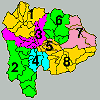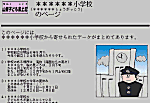Conference to introduce results from the 100-School Networking Project (Phase
II)
Elementary school meeting
Recording the Daily Lives of Children in Yamanashi
Hitoshi Ishikawa, Elementary School attached
to Faculty of Education of Yamanashi University
1. Introduction
- Yamanashi prefecture was chosen as one of the major projects in the 100-School
Networking Project Phase II (the practical experimentation of the advansed
utilization of school networking) to collaborate in the promotion of an education-center
type of network. Some projects were carried out mainly by Yamanashi Prefecture's
Education Center. Here, we report on efforts to record the daily lives of
children in Yamanashi. For this project, children gathered information and
created a home page to make this information accessible to children living
in other areas of the prefecture. Since children would make up the majority
of those accessing this site, we tried to create a web site that would be
easy for children to use.
2. The Details of Creating a Web Site
(1) Networking among elementary schools in Yamanashi prefecture
- Although a growing number of schools in Yamanashi prefecture are connected
to the Internet, the number of connected elementary schools remains relatively
small. Fewer than 10% of elementary schools have a home page.
(2) The keyword is area collaboration
- The relatively low participation limits the collaboration that can be conducted
in this area. Our efforts to implement our project as a prefecture-wide project
assume that this situation will improve. We have thus appealed to all 218
elementary schools in the prefecture to join the network.
3. Progress and how we proceeded
(1) Progress
- To create a web site, we maintained correspondence with members of the Yamanashi
School Net Education Research Group, chosen from a mailing list, to discuss
web site content and a questionnaire we drew up. We sent the questionnaire
to prefecture elementary schools in October 1997, requesting that they be
returned by the end of October. Over a period of a month, we created the web
site based on data gathered from the questionnaire responses.
(2) How we proceeded
- Sending and collecting the questionnaire: Yamanashi Prefectural Education
Center
- Editing data (creating the web site): Elementary School attached to the
Faculty of Education at Yamanashi University
4. Features of the teaching material found on the web site, Record of Daily
Lives of Children in Yamanashi
(1) Information published
- On the page for each school, we published a picture of the school and the
following information, acquired from responses to the questionnaire.
- Official school name, its founding date, its age, elevation above
sea level at the school location, approximate dates for first cherry blossoms
and snowfall in the school area, summer and winter vacation schedules for
FY 1997, popular school events, the school's good qualities, games popular
with children, nearby sightseeing spots, local seasonal festivals, and farm
products produced in the area.
We also published each school's address and telephone number and established
a link button for the school's home page, in cases where schools had home
pages.
- We scanned in photographs of each school and displayed them on the home
page.
(2) For ease of use
- User side clickable maps
- Link button using hot text
- Matching hot text and numbered points on the map
(3) Home page directory
- Map of the entire prefecture®Eight regions
of the prefecture®64 cities, towns,
and villages®Each school's page
-
(4) Consideration for users
- For both children and teachers (adults), we prepared instructional pages
for use of our home page and pages describing how the home pages were prepared.
For children, we noted the written material found on each school's page and
instructions for using the clickable map. For teachers (adults), we noted
the written material on the page for each school and how we made the home
page. For use by adults, one page provides the names of all 218 schools in
the prefecture. Teachers can download this data into word processors, databases,
or spreadsheets, from which study sheets can be prepared for use by students
when working with the Record of Daily Lives of Children in the Yamanashi home
page.
5. Instructions
(1) Using it on the network
- The Record of Daily Lives of Children in Yamanashi is found on the home
page of Yamanashi Prefecture's Education Center. The document can be used
on-line.
(http://www.ypec.misaka.yamanashi.jp/fudoki/zenken.html)
(2) Working off-line
- For schools not connected to the network, the Yamanashi Prefectural Education
Center distributes CD-ROMs that include all information, enabling any school
to use the web site teaching material.
6. Using the Record of Daily Lives of Children in Yamanashi: a Lesson
- In December 1997 when the Record was near completion, we conducted four
hours' worth of lessons for third graders (covering basic familiarity with
computers®doing research®informing
others). During these lessons, we tried to get across the potential for research
of using a home page on the Internet.
7. Conclusion
- As of February 16, 1998, over 98% of the schools questioned had returned
questionnaires. Our home page contents have been enriched by histories for
each school and the features of each local area, based on information gathered
from students. Our lesson succeeded in quickly acquainting children with computers,
and we found students to be eager to find out more about the lives of their
counterparts in other parts of the prefecture, using the computers and the
network. With an increased number of schools connected to the network, we
hope to broaden the base of students who are able to communicate with each
other. We plan to review our work and correct mistakes made during editing,
send second requests to schools that did not respond to the questionnaire
in the first round, and continue to improve our home page to make it more
useful.
 Conference to introduce results from the 100-School Networking Project (Phase II)
Conference to introduce results from the 100-School Networking Project (Phase II)








 Conference to introduce results from the 100-School Networking Project (Phase II)
Conference to introduce results from the 100-School Networking Project (Phase II)